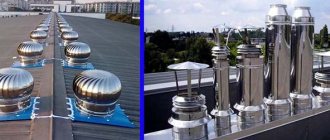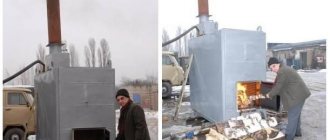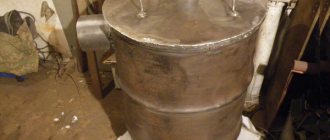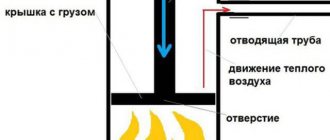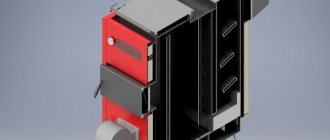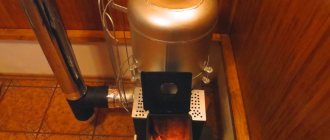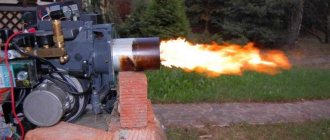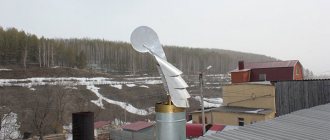Advantages and disadvantages
The main advantage of the rotary deflector is an increase in draft in the exhaust duct by an average of 20%. This is achieved due to the formation of air vacuum at the inlet of the turbo deflector during its operation. The increase in thrust will depend on the rotation speed of the active head, and its speed on the air flow speed.
Briefly, the following advantages of a rotating deflector can be highlighted:
- complete autonomy;
- eliminating the influence of weather factors (precipitation, sharp gusts of wind) on air exchange;
- increase in traction by ~20% at minimal cost;
- elimination of “backdraft”;
- low cost with a significant increase in the efficiency of the ventilation system;
- protection of ventilation shafts from foreign objects entering them;
- reduction of fat deposits and dust in ventilation ducts;
- long service life (at least 15 years);
- no special skills required for installation;
- Possibility of decorative design of the channel outlet.
The main disadvantage of the device is the dependence of its effectiveness on weather factors, namely the lack of wind. In complete calm, such a device ceases to perform its unique function, but at the same time its other qualities remain in effect, like a regular standard deflector.
Another disadvantage is the icing of the turbine in the winter season. In this case, you will have to knock off the ice film from the blades to restore the operation of the mechanism.
Features of the device
A ventilation deflector is installed to increase draft in air ducts, shafts and channels.
This device, by deflecting air flows created by the wind, creates a low-pressure zone at the outlet of the ventilation system. The air masses in the pipe, trying to compensate for the vacuum, rise to the head of the pipe, thereby increasing thrust. This is a description of the operating principle of all deflectors, of which there are a huge number of designs. Many devices not only deflect air flows, but also increase the speed of their passage over the head of the ventilation pipe by narrowing the channel, thereby significantly increasing draft (airbrush principle).
Proper use of the deflector helps increase the productivity of the entire ventilation system by up to 20%; it is especially useful on ventilation ducts with large horizontal sections and bends.
In addition, the deflector on the ventilation pipe perfectly protects against the entry of various debris, small birds, insects, and most importantly, precipitation. Basically, the material from which these devices are made is resistant to corrosion. This is galvanized or stainless steel, ceramics or plastic.
DIY turbo deflector
Drawings for a turbo deflector
There are 2 options for a homemade turbo deflector, which you can easily construct with your own hands. In the first case, the body is made from a metal container in the shape of a cylinder. The blades are cut from the walls; they need to be bent outward. A housing is installed on the rotary axis without the use of bearings. The base is made from a piece of metal pipe of suitable diameter. The unit is attached to the ventilation outlet with a clamp. The design is inferior in appearance to factory models, so it is installed on outbuildings.
The second option is made using a drawing of a turbo deflector, which is transferred to cardboard, and the parts are cut out with scissors. The parts are transferred to the metal using ready-made patterns. Before fastening together, fitting and fitting are done. Self-tapping screws, bolts with nuts and metal strips are used for connections. The diameter of the ring is measured at the installation site; the shaft and bushing are made of the same metal.
Blueprints
First, the needs are calculated, then drawings are made that can be downloaded on the Internet. The drawing is important if the amount of sheet steel is limited. This way the parts will be arranged compactly and no extra space will be wasted. The cut parts are assembled into a layout to check the accuracy of the dimensions.
The need for a device can be calculated using the formula N = V / P, where:
- N is the number of deflectors;
- V—ventilated volume;
- P - device performance (available in the technical data sheet).
The ventilated volume is calculated by multiplying the volume of the room by the required air exchange.
Electric fan as a traction enhancer
Electric fans are specially designed for installation and use in fireplaces and stoves that operate using wood. In an environment where there is a large percentage of soot, soot and at high temperatures.
You can learn how to improve chimney draft using a fan from the following instructions.
The electric fan housing is made of high-strength galvanized steel. The main element serving as protection is a special grille built inside the structure. It is this that serves as protection and prevents various dirt and foreign objects from entering the structure. You can learn more about the installation and design of the electric fan by watching the video in this article.
To operate such a fan, you need a special motor that runs smoothly and in any weather. If you don’t know how to increase draft in the chimney, this option will help you independently control not only your work, but also the temperature.
How to make a TsAGI deflector for a chimney pipe with your own hands
The process of developing and assembling a deflector for a chimney consists of four stages: drawing, creation of blanks, assembly, installation of the structure and its fastening directly to the chimney.
Required Tools
You will definitely need:
- a sheet of thick paper for drawing and layout;
- marker for marking;
- riveter for connecting structural elements;
- metal scissors for cutting out parts;
- drill;
- hammer.
Don’t forget about the necessary tools before installing the deflector
Development of a drawing of a TsAGI deflector model
There is an algorithm for how to make a deflector for a chimney pipe with your own hands. It is recommended to perform the first stage on paper. First you need to calculate the dimensions of the diameter of the nozzle and the upper cap of the structure, and also calculate the height of the reflector.
For this, special formulas are used:
- diameter of the upper part of the deflector - 1.25d;
- outer ring diameter - 2d;
- height of the structure - 2d+d/2;
- ring height – 1.2d;
- diameter of the cap - 1.7d;
- the distance from the base to the edge of the outer casing is d/2.
Where d is the diameter of the chimney.
To make the task easier, a table containing ready-made calculations for standard sizes of metal pipes will help.
| Chimney pipe diameter, cm | Outer casing diameter, cm | Height of outer casing, cm | Diffuser outlet diameter, cm | Cap diameter, cm | Installation height of the outer casing, cm |
| 100 | 20.0 | 12.0 | 12.5 | 17.0…19.0 | 5.0 |
| 125 | 25.0 | 15.0 | 15.7 | 21.2…23.8 | 6.3 |
| 160 | 32.0 | 19.2 | 20.0 | 27.2…30.4 | 8.0 |
| 20.0 | 40.0 | 24.0 | 25.0 | 34.0…38.0 | 10.0 |
| 25.0 | 50.0 | 30.0 | 31.3 | 42.5…47.5 | 12.5 |
| 31.5 | 63.0 | 37.8 | 39.4 | 53.6–59.9 | 15.8 |
If the chimney has a non-standard width, then all calculations will have to be done independently. But, knowing the formulas, it is easy to measure the diameter of the pipe and determine all the necessary indicators to use them when drawing up drawings.
When the patterns are made, it is recommended to first assemble a paper prototype of the future reflector. Even if you are an experienced craftsman and are sure that you can design a deflector for a stove chimney with your own hands without any problems, you should not skip this stage, since it will help you identify possible errors and shortcomings, and correct the calculations or drawing. Only after creating the correct paper layout, which confirms that the deflector diagram is accurate, can you move on to the next stage.
Step-by-step instruction
There is an order of work that must be followed, otherwise you will not be able to connect the individual parts of the chimney deflector yourself with your own hands.
The procedure is as follows:
- Using paper blanks, transfer the template to the surface of the metal from which you plan to make the reflector. Carefully trace the outlines of the paper parts. You can use a permanent marker, special chalk, or even a simple pencil for this purpose.
- Using metal scissors, cut out the blanks of the necessary structural parts.
- Along the entire contour of the cuts, the metal must be bent by 5 mm and carefully passed with a hammer.
- Roll the workpiece into a cylinder shape, drill holes for fasteners so that you can connect the structure with rivets. Welding is permitted, but not arc welding. You need to be careful not to burn the metal. Choose the distance between the main fastening points from 2 to 6 cm, it varies depending on the size of the finished structure. The outer cylinder is rolled up and fastened in the same way.
- By bending and connecting the edges, make the remaining parts: an umbrella and a protective cap in the form of a cone.
- You need to cut fastening elements from a galvanized sheet - 3-4 strips: width 6 cm, length - up to 20 cm. Bend them along the entire perimeter on both sides and go over them with a hammer. From the inside of the umbrella, you need to drill mounting holes, stepping back from the edge by 5 cm. 3 points will be enough. After this, secure the metal strips to the cap with rivets. Then they must be bent at an angle of 90 degrees.
- Connect the diffuser and cone using rivets to the inlet pipe. Having made a deflector for a round pipe with your own hands, you can begin installing it.
A Volper chimney deflector can be created using a similar method. Its design is very similar to the TsAGI model, but there are some differences in the upper part. They are also made of stainless steel, galvanized or copper.
Advantages and disadvantages of turbodeflators
What will a user get if he makes a turbo ventilation deflector with his own hands or buys one? A lot of advantages and only positive impressions about his work. Here are the advantages that a product for ventilation or chimney has:
- The turbo deflector head, which rotates, enhances air exchange in the ventilation or chimney pipe. No backdraft is formed, and the under-roof space does not accumulate condensate. In addition, the rotary device works much better than a regular deflector.
- The product runs exclusively on wind energy and does not consume electricity. Therefore, there will be no extra costs, unlike using electric fans.
- If you properly care for the equipment and perform correct installation, the service life will be 10 years, or 100 thousand hours of operation. If we take stainless steel turbo deflectors, their service life is 15 years. In comparison, fans work 3 times less.
- Snow, hail, rain, leaves, and rodents will not enter the ventilation duct. The turbo deflector is used in areas with strong and frequent gusts of wind.
- The design of the equipment is light, convenient and compact. Turbo deflectors with a diameter of 20 cm or more weigh slightly less than the TsAGI deflector. The large size product, which is 680 mm, weighs approximately 9 kg. To understand the difference, let’s say that a TsAGI deflector of the same diameter weighs up to 50 kg.
- Easy to install. Even a beginner can cope with this task. All you need is instructions and a standard set of tools.
This is why turbo deflectors are so often used. But along with the advantages, the products also have some disadvantages:
- When compared with other types of deflectors, the turbo deflector is somewhat more expensive. True, if you do it yourself, it will cost less;
- under unfavorable atmospheric conditions, for example, if there is no wind, low temperature or high humidity, the device may simply not work and stop. But if the deflector is constantly in motion, then it is less susceptible to icing;
- The use of a deflector for rooms with increased ventilation requirements, such as a medical laboratory, industrial premises, buildings with chemical substances, cannot be considered the only solution. You still need to install fans.
Depending on the material used, the price of the device can be quite high. Still, these disadvantages are very few, so many people prefer to use a deflector for their ventilation system.
This is interesting: DIY construction from heat blocks
Types and characteristics
Nowadays, there are many types of deflectors for ventilation, among them the main ones are:
- Tsaga deflector;
- Grigorovich deflectors;
- H - shaped deflectors.
There are open structures that are divided by shape:
- can be flat;
- semicircular;
- with an opening lid or gable.
According to the principle of operation it happens:
- rotary deflector;
- turbine.
Like a weather vane.
Next, we will look at the most popular types of ventilation deflectors.
Chimney deflector
Very often, deflectors are installed on the chimney; it is installed in order to provide good draft for removing smoke. Thus, the deflector increases the operation of the equipment by twenty percent, this increases better fuel combustion and improves heat transfer.
Also, installing a deflector prevents atmospheric precipitation and various debris from entering the chimney.
Air conditioner deflector
Such designs are almost nothing like classic deflectors. They are screens - reflectors that redistribute the air masses produced by the air conditioner.
Therefore, air masses are directed not at a person, but at the floor or parallel to the ceiling, dissipating without losing their pressure.
Rotary deflector
This type of deflector increases the operation of the natural supply and exhaust system by four times, and at the same time, such a deflector does not require connection to electricity.
The rotary deflector consists of a movable head with blades, which are mounted on a base and attached with bearings.
The operating principle of the rotary deflector is as follows:
The wind gets into the blades and due to this the head begins to move, thereby the air is discharged and the thrust increases.
Thanks to the bearings, the head rotates at a constant speed, even in strong winds.
Vane
Deflector - weather vane is a special device, the body of which moves along with curved visors; they are connected to a bearing mount.
There is a weather vane on top of the structure; it allows the entire device to always be “downwind.”
This device works like this: air masses pass between the canopies, accelerate and create a rarefaction zone, due to this, traction is increased, fuel burns better and air exchange improves.
Such designs are good to use to prevent backdraft, flame extinction and sparking.
You can make such a design yourself; to do this, you need to install the structure on the cut of the chimney pipe; the fastening will be a bearing assembly and a ring.
Base deflector
Such deflectors are designed to ventilate basement floors and rooms, as well as to remove moisture. Such devices can be used in both forced and natural ventilation systems.
Another base deflector prevents various small animals, dirt, and meteorological precipitation from entering the basement.
The length of the deflector pipe is easy to adjust and, if necessary, it can be extended or sawed off to the desired height.
Existing types of deflectors
Today there are a huge number of different designs of such devices. Among them, the most popular models are:
- TsAGI is an effective and simple design wind redirection device.
- Grigorovich is also a very popular deflector design.
- H-shaped device for effectively increasing draft in ventilation and chimneys.
In addition, various designs of open deflectors are often used both on the heads of ventilation and chimney pipes.
All varieties of models can be classified according to some distinctive qualities:
- According to the shape of the top of the device.
- Rotating (rotary or turbine).
- Deflectors-vanes.
In addition to such a common material as metal, these devices are made of plastic. The plastic ventilation deflector is less durable than its steel counterpart, but has a lower cost and a more sophisticated appearance.
That is why plastic devices decorate the ventilation shafts of most private houses. But besides its service life, it has another serious drawback. Plastic does not withstand high temperatures, so it is not recommended to use it on chimneys.
Weather vanes - deflectors are usually installed on chimneys, but they are also quite suitable for ventilation systems. The air flow, passing through a system of visors and slots in the product body, is redirected due to which a low pressure zone is created above the pipe. It should be recalled that the weather vane has a design that allows this device to be constantly turned, with the working side facing the wind.
Due to its design, the rotating ventilation deflector not only increases draft in the ventilation shaft, but also effectively protects it from various debris and insects. This device, as a rule, has a spherical shape, so it stands out among all with its original design.
There is another original type of ventilation deflector - rotary, or as it is also called turbine. This device converts the energy of air flows into the rotational movement of a turbine, which spins the air according to the principle of a tornado, thereby creating an increase in draft in the air duct. This device shows excellent results even in the warm season, creating draft in the ventilation system.
Selection rules
You can select the optimal deflector based on the goals and tasks assigned to it. It is also worth considering the conditions in which it will operate.
A simple chimney is a cap on a wood-burning chimney, made in the form of a regular umbrella, and has the following advantages:
- maintains the necessary traction both in calm conditions and in the movement of air masses with a power of up to 10 points;
- does not create excessive pressure on the pipe, due to which even in a severe storm the chimney remains in its place; rather, the umbrella itself can break off and fly away;
- has a simple and understandable design;
- practically does not coke or clog, and is quite easy to clean;
- due to the imperfection of the aerodynamic structure, it is insensitive to the shape of the umbrella; if the building is located in the wind, then the chimney can be made in the form of a tent, this greatly simplifies its use and opens up great opportunities for the implementation of design ideas.
At the same time, there are serious disadvantages, such as:
- in weak winds it reduces draft, and the stronger the heating element works, the weaker it is. This is quite dangerous, since in cold winter weather, in the absence of wind, the stove can “choke” and breathe fumes into the living quarters;
- in strong winds, on the contrary, it creates too much draft. This significantly reduces the efficiency of indoor stoves and fireplaces;
- in gusty winds it can cause blowing into the pipe and creating a reverse draft effect.
The aerodynamic open model maintains sufficient draft in any wind for efficient operation of stoves and boilers using liquid fuel and gas. Such deflectors can freeze, they easily become littered and quickly become covered with soot and soot, however, they are easy to clean.
The disadvantages include the following:
- complex body of rotation;
- as a result of the load created by air masses, the umbrella itself can easily fly off the chimney, and at the same time, the direct mechanism of the device can collapse the pipe itself;
- with strong gusts of wind from force 8, the lateral pressure on the structure increases significantly and further increases in accordance with the power law;
- open structures are quite poor at reducing strong dynamic loads resulting from gusts of wind, which is why in no case should such a model be placed on pipes made of brick;
- the modification cannot be used for pyrolysis heat-generating mechanisms, otherwise, when wind occurs, all pyrolysis gases will be sucked out and the stove or boiler will simply go out;
- not suitable for creating design elements, since it is unsuitable for decoration; all kinds of blotches and figures only worsen the overall aerodynamic status of the structure as a whole.
By the way, an interesting study was conducted in the USA. There, at one time, they studied issues related to open deflectors and installed them on locomotives to check the degree of increase in efficiency at low speed. At the same time, the result was the most depressing - at mid-speed, fire began to burst out of the pipe and not a single train was able to reach its maximum speed. In general, the open version of the deflector should be recommended for all types of heating devices, with the exception of pyrolysis ones. At the same time, it must be checked and cleaned at least once a quarter. It is optimal for a chimney with low draft force, it is most effective for wood-burning sauna stoves; not a single case of people burning out due to the ventilation deflector in saunas has been recorded.
The closed or as it is called “perfect” type has such advantages as:
- provides stable draft, which is sufficient for stoves and boilers of any type;
- not prone to freezing and clogging from the inside;
- Dust and ice formed on the outside do not significantly change the operation of the device.
There are also disadvantages, however, users claim that they are not so significant, namely:
- when exposed to strong winds, it gives maximum pressure on the pipe, and then increases linearly, so the chimney under the deflector should be further strengthened with guy wires;
- has rather complex design and technological parameters;
- cannot be used as a design element, since any additional elements significantly reduce the overall level of aerodynamics.
Models may differ in appearance, purpose and material. Most often, plastic, stainless steel or aluminum are used to produce deflectors. In rare cases, copper may become a raw material for production. Many users prefer the sandwich model.
What is a deflector?
Today, a cylindrical, cone-shaped or rounded deflector body can be seen on the roofs of private houses. In essence, the deflector is an aerodynamic nozzle designed to create additional vacuum at the cut of the ventilation pipe. As a result, the pressure difference above the pipe and inside the room increases, the draft and performance of the ventilation system increases.
Structurally, any deflector consists of three units:
- Housings with fastenings that ensure reliable and durable installation at the end of the ventilation pipe;
- Air flow capture systems consisting of several fixed airfoils or a rotating element, as in the case of turbine deflectors;
- A cap or protective cover that covers the pipe section from the penetration of rain, snow, curious birds, insects, mice and other living creatures.
For your information!
A remarkable property of the deflector is its absolute autonomy. The device, which provides an additional increase in thrust by almost 10-20%, operates without external sources of electrical or thermal energy. To operate, the ventilation deflector requires one condition - a constant, stable horizontal wind flow, preferably in one direction. In conditions of constant air flow, the deflector nozzle allows you to reduce the height of the ventilation pipe on the roof by almost half. When there is no wind, the deflector practically does not work.
Increasing draft due to compression of additional air flow is also used in chimneys and blowdowns, when it is necessary to quickly remove combustion products, smoke, fumes, and soot from a room or combustion chamber. The deflector helps to sharply intensify combustion. For example, in the era of steam locomotives, an improvised booster was used: in order to sharply increase the power of the steam engine, steam from the boiler was thrown out through the chimney, which increased the combustion intensity and engine power by almost 70%.
Advantages and disadvantages of a turbo deflector
The following arguments can be made in favor of using a turbine:
- Fast air exchange. The rotating turbine head promotes rapid air exchange in the ventilation shaft, prevents the formation of reverse draft, and protects the roof space from the accumulation of condensate. The operating efficiency of the rotary device is much higher than that of a conventional deflector.
- It does not consume electrical energy, unlike electric fans, but works thanks to the power of the wind. This puts the turbo deflector among the most cost-effective devices.
- The average service life with regular maintenance and proper installation is about 100 thousand hours or 10 years; stainless steel models can last up to 15 years. This is three times longer than the operating time of the fans.
- Protection from precipitation. Prevents snow, hail, and rain from entering the ventilation ducts. Can be used in regions with strong and frequent winds.
- Compact and lightweight design. Devices with a base diameter greater than 200 mm weigh significantly less than the TsAGI deflector. The largest model (680 mm) weighs only about 9 kg; in contrast, the TsAGI deflector with the same base diameter can weigh about 50 kg.
- Easy installation does not require special knowledge and skills.
The following facts speak against its use:
- The device is quite expensive compared to conventional deflectors.
- Unfavorable atmospheric conditions such as lack of wind, high humidity and freezing temperatures can lead to a complete stop. It should be noted that moving turbines are subject to icing to a much lesser extent.
- The deflector cannot be used as the main means for removing contaminated air in rooms with increased ventilation requirements: in medical laboratories and in industries where work involves chemical and explosive substances.
We suggest you familiarize yourself with Marking the foundation for a bathhouse with your own hands
The price of a rotary deflector is quite high compared to static devices; it depends on the material used for manufacturing - stainless steel, polymer-coated steel, galvanized steel.
But the efficiency of work pays off all costs.
Image gallery
Photo from
The turbine deflector is constantly attacked by atmospheric negativity: rain, gusty winds, low and high temperatures, their sudden changes
It is important that the selected device lasts a long time, just as a stainless steel deflector will last. A galvanized deflector will last 5 years, after which the protective zinc layer will collapse, erode and no longer protect the steel from rusting.
A galvanized deflector will last 5 years, after which the protective zinc layer will collapse, erode and no longer protect the steel from rusting.
By painting the elements of the galvanized deflector with enamel before assembly, we will extend the operation two or more times. It is necessary to completely cover the parts, without allowing gaps
A polymer coating applied at the factory will actually equalize the service life of a stainless steel device and a painted deflector. The polymer shell will prevent the weathering of zinc
Stainless steel exhaust device
Galvanized turbine deflector
Painting the deflector with waterproof enamel
Protective and decorative polymer coating
What is a turbo deflector and why is it needed? (+video with the device)
A turbo deflector (or rotational deflector) is a metal product that is installed at the exit (at the very top) of the ventilation shaft. Its task is to enhance natural cravings.
In addition to its main task, this element also performs a protective function. It protects the ventilation duct from birds, precipitation and reverse draft.
Design and principle of operation
Structurally, the product consists of 2 parts:
- The turbine head is a round moving part consisting of a large number of thin bent plates, “assembled” with small gaps between each other. The plate material is metal (usually galvanized steel or aluminum), up to 1 mm thick. The head is fixed on top of the supporting part, on bearings.
- Supporting part - needed for fastening to the ventilation shaft exit. May have a rectangular, square or round cross-section. The nozzle (transition) for installation can have different sizes - from small (about 10 cm) to large (more than 50 cm).
Now let's talk about how this product works.
The turbo deflector, installed on top of the ventilation shaft, is located in an open place and is blown by the wind. The air flow hitting the blades (plates) sets them in motion - the head begins to rotate (and it can only rotate in one direction). Since the thickness of the metal is small, even a light wind of 0.5 m/s is sufficient for rotation. The turbine can only rotate in one direction.
Due to the rotation of the plates in the ventilation duct, the draft (vacuum) increases. As a result, the operation of natural ventilation improves: air is removed from the premises more efficiently, and the system operates more stably.
Comparison of turbo deflector and TsAGI deflector (video)
Where is it useful to use?
The turbo deflector can be used for ventilation of a wide variety of buildings - from residential private houses to industrial facilities. To clarify, installing turbo deflectors is useful for the following buildings:
- private houses - from residential cottages to summer country houses;
- one-story utility and non-residential buildings: sheds, garages, barns, bathhouses, agricultural buildings (poultry houses, barns);
- industrial enterprises - regardless of what exactly they produce;
- multi-apartment residential buildings;
- public buildings;
- sport complexes;
- office and shopping centers;
- warehouses.
The products can also be used for ventilation of the under-roof space.
The turbo deflector can be installed on the following types of pipes:
- exhaust ducts - both individual (for example, only from the garage) and “common” (the ventilation shaft of an apartment building);
- chimneys - fireplaces, boilers, stoves.
Turbo deflector on the roof of a private house
If we are talking about installing the product on a chimney, there is a temperature limit. When choosing a nozzle, you need to look at how many degrees it can be used.
Such products can be used both on natural ventilation exhaust ducts and on air ducts into which mechanical exhaust hoods (fans) are supplied. In the second case, turbo deflectors, by increasing traction, allow you to save energy - turn on the hoods less often.
Pros and cons of use
The advantages of using include the following nuances:
- increasing the productivity of natural ventilation systems;
- draft stabilization - even in gusty winds, the vacuum in the exhaust duct will be more stable than in an air duct without a turbo deflector;
- work without electricity;
- additional protection of the ventilation duct from precipitation, birds, and various debris;
- additional protection of the channel from ice - due to more stable thrust and rotation of the turbine;
- aesthetic design - turbo deflectors do not spoil the appearance of the roof, regardless of the style of construction;
- low weight (due to thin blades) - in this regard, turbo deflectors are better than TsAGI deflectors (for example: a turbo deflector with a base diameter of 680 mm will weigh about 9 kg, and a TsAGI deflector of the same size will weigh about 50 kg);
- ease of maintenance, reliability and durability - the design and principle of operation of the product are extremely simple, there is practically nothing to break in them, due to which turbo deflectors have a service life of approximately 10-15 years.
There is only one significant drawback. If there is severe frost outside, there is precipitation and there is no wind, the head will stop and may freeze. Due to freezing, the turbine will not rotate, and the narrow gaps between the “petals” (plates) may become clogged with ice. As a result, the draft in the ventilation duct may drop or disappear altogether.
To be fair, we note that such situations rarely occur in practice: absolutely windless weather with severe frost and precipitation does not last long.
About manufacturers and costs (+ video review with unpacking of the turbo deflector)
Products from the following manufacturers are common in the markets of the Russian Federation and CIS countries:
- Rotowent (Poland). They can be installed both on chimneys and ventilation shafts - designed for temperatures up to +500º.
- Turbomax (Belarus). They are positioned as “smoke hoods”, but in fact they can also be used for ventilation ducts.
- Era (RF).
- Turbovent (RF).
For your reference, here is the cost of several models with different sizes:
- Diameter 100 mm, galvanized - about 2000-2200 rubles.
- Diameter 110-125 mm, stainless steel - about 3100 rubles.
- Diameter 150-160 mm, stainless steel - 3600-3700 rubles.
- Diameter 200 mm, stainless steel - about 4000-4200 rubles.
- Diameter 315 mm, galvanized - about 3900-4000 rubles.
- Diameter 500 mm made of stainless steel - about 6900-7000 rubles.
- Diameter 680 mm, galvanized - about 12,000-13,000 rubles.
Popular product types
You've probably noticed that they come in different shapes. Modern devices may have different tops:
- Flat
- Semicircle
- With lid
- With a gable gable roof
Semicircular cap
The first type is most often installed on houses made in the Art Nouveau style. For ordinary modern buildings, a semicircular cap is mainly used. The gable roof of the deflector does the best job of protecting the chimney from snow.
Chimneys are mainly made from galvanized iron, less often from copper. But today products coated with enamel or heat-resistant polymer are becoming fashionable. If the device is used on ventilation ducts where there is no direct contact with heated air, then a plastic cap can be used.
The designs of deflectors are also different.
In the domestic market the most popular are:
- TsAGI deflector, spherical with rotation, open “Astato”
- Grigorovich device
- "Smoke Tooth"
- Round chimney "Voller"
- Star "Shenard"
Various options for chimney caps
The TsAGI deflector has become the most popular in Russia. Its package includes:
- Branch pipe (inlet)
- Frame
- Diffuser
- Umbrella
- Brackets
You can buy a factory deflector and install it on the chimney, but some people prefer to make it themselves from scrap materials. To do this, you should follow a few simple rules.
This is a mechanism that has a rotating body and is connected to a bearing unit; specially curved parts are attached to it. The weather vane itself is located on top, it allows the entire device to constantly stay in the wind.
The ring with a bearing unit built into it is attached to the edge of the chimney using strong bolts. The air flow passing between the visors is accelerated, which leads to the creation of a rarefied zone. The thrust, accordingly, increases and the efficiency of removal of combustion products increases.
How to make a chimney deflector with your own hands
First you need to decide what material it will be created from. It can be galvanized iron or stainless steel. Copper is also suitable, although it is an expensive material. The use of these particular metals is due to the fact that the deflector must be as resistant to temperature changes and atmospheric influences as possible.
The device has its own specific parameters that must be adhered to. For example, the height of the chimney should be 1.6-1.7 parts of the internal diameter of the pipe, and the width should be 1.9.
The sequence of work on creating a deflector yourself is as follows:
- On cardboard we draw a diagram of the main parts.
- We transfer the patterns to metal and cut out individual parts.
- We connect all the elements to one another using fasteners or welding.
- We make the brackets from steel needed to mount the cap on the surface of the chimney.
- We assemble the cap.
A self-made deflector is first assembled and only then mounted on the pipe. The first to install is the cylinder, which is fixed with fasteners. Using clamps, a diffuser is attached to it, as well as a cap in the form of a reverse cone. This simple element allows the device to function in any wind.
Watch the video and do it yourself step by step:
To make your own cap you will need the following items and tools:
- Rubber or wooden mallet
- Hammer
- Bar
- Clamps
- Scissors for working with metal
- Steel corner.
To simplify the process of assembling the device, all parts have specially cut corners on both sides.
Installing a deflector is mandatory and is most effective if there is an indirect chimney.
When making the device yourself, you must strictly adhere to the proportions indicated above. If the deflector installed on the chimney does not meet these parameters, then it will not be able to perform its main function of creating good draft.
We make the cap ourselves, video review:
When making metal blanks yourself, it is best to do this using cardboard patterns cut to the required dimensions. Having attached them to a sheet of metal, it will be enough to trace the details along the contour and you can safely cut them out without fear of making a mistake.
If the pipe has a maximum permissible diameter, then installation will require the use of a stretcher made of wire.
The most common models of ventilation deflectors
Deflector draft amplifiers are widely used in private housing construction and in multi-storey buildings as a means to increase the efficiency of the ventilation system. Today, several designs of ventilation deflectors are best known:
- The deflector model developed by TsAGI - the Central Aerodynamics Institute, that’s what it’s called. Heavy, bulky, designed for high altitudes and huge air flows;
- Grigorovich's system, shown in the photo below. One of the most successful deflector schemes. A simple and effective design that you can easily make and install on the roof with your own hands;
- Turbo ventilation deflectors are distinguished by the presence of a straightening dome-shaped grille capable of rotating under the influence of air flow and at the same time creating a vacuum inside the dome;
- Sail or weather vane deflectors.
For your information! Despite external differences in design, all deflector systems operate on the same principle of flow injection.
Grigorovich's scheme is strikingly simple and highly effective. In fact, the ventilation deflector is built in the form of two truncated cones, closed by a cap. The low weight and strength of the deflector allow it to be installed on relatively weak ventilation and plastic ventilation pipes. The device is insensitive to the direction of air flow, pulsations and wind flow.
Deflectors according to the Grigorovich scheme today occupy 80% of the market for ventilation draft amplifiers for ventilation systems of private houses.
According to Grigorovich’s scheme, an industrial prototype of a ventilation deflector under the DS brand is being manufactured, which already has an additional protective mesh against birds and parasites.
DS models show maximum efficiency in enhancing draft in the ventilation pipe only on a flat roof. In addition, the presence of a mesh often leads to freezing of the screen, but it is impossible to do without protection, since ventilation pipes are often used by birds and insects to enter the building.
Deflector system developed by TsAGI
TsAGI models are the main ones for most industrial facilities. Structurally, it is a two-level deflector cap with a lower and upper air flow around the body. To get rid of resonating noise and whistling in strong winds, the ventilation deflector housing is covered with an annular screen.
According to the developers, the screen allows you to protect the body from the formation of ice and snow plugs.
TsAGI really wanted to make their deflector for the ventilation pipe highly efficient and reliable, but in practice it turned out to be a very expensive and bulky product that suffers from icing in winter and quickly rusts even with a small amount of chemically active oxides of sulfur, nitrogen and phosphorus.
The TsAGI deflector has not taken root anywhere except industrial production workshops. In the private sector, the model did not take root; no attempt was even made to copy it; in addition, for effective operation, the ventilation pipe with a deflector must be raised 1.2-1.5 m above the roof ridge.
Turbine as a way to increase draft in a ventilation pipe
An example of one of the most interesting ways to enhance thrust is turbine circuits. The most common dome turbine is shown in the photo.
The design consists of more than two dozen blades made of thin sheet metal, assembled into a bud. The outer shell of the blades is attached to a cantilever mounted axis of rotation.
The deflector is installed only on round ventilation pipes. The dome-shaped placement of the blades makes it possible to effectively capture horizontal air flows of 0.1-0.5 m/s in horizontal and vertical directions, which makes the turbine extremely efficient. For the dome to work, a weak “thermal” from the roof heated in the sun is enough.
Another advantage of the turbine is its unpretentiousness in choosing an installation location. As a rule, domes are installed on a ventilation pipe, at a height of 30-35 cm above the roofing, which has virtually no effect on the rafters and sheathing.
The turbine circuit deflectors are insensitive to dust storms and intense condensation. Firstly, even at a low rotation speed, the fallen film of moisture breaks off and drips from the sharp edges of the blades. Even if the outer shell is blocked for some reason, the ventilation system will still work, but with 10-15% less efficiency.
Sail and hood models
Vane or hood models of deflectors are very unusual in appearance.
In fact, this is the only scheme in which the Bernoulli or ejection effect is fully used. The operating principle of the device is based on the ability of the weather vane to turn to the leeward side. The incoming air flow creates a vacuum in the ventilation pipe that is 15-20% higher than in Grigorovich systems or in a turbine.
The design is equipped with a kind of hood, which acts as a weather vane wing and at the same time covers the exhaust hole of the ventilation pipe from rain and snow.
For effective operation, the ventilation pipe with a hood deflector must be raised to the very top of the ridge, where there are no reflected air flows. The main disadvantage of the weather vane option is its high inertia; during sharp gusts of wind, the weather vane often does not have time to turn into the wind, and some of the exhaust gases are driven back into the ventilation system of the house by dynamic pressure.
Like a turbine, the feathering effect of increasing thrust and the performance of the hood deflector are practically independent of condensation, dust and air temperature.
One of the varieties of weather vane design is tubular deflectors. Essentially, this is a double-sided air diffuser - a confuser, which is also rotated by the air flow in the wind. The draft amplification factor in the ventilation pipe in such a device is higher than that of the Grinevich scheme, but lower than that of the classic hood design.
Self-production of a turbo deflector
Making a turbo deflector with your own hands from scrap materials will save money. Work begins with preparing a drawing, as well as all the necessary tools and materials. To work you will need the following:
- steel sheet - 0.5-1 mm thick or plastic;
- drill with drills;
- cardboard sheets;
- riveter;
- scissors.
Create a drawing
If you do not have the skill to construct drawings, then you can use a ready-made project. But at the same time, all parameters of the device must correspond to the specific product, so they are carefully checked. When creating it yourself, you need to correctly calculate the characteristics of the device, adhering to the table with the main dimensions:
| Planting diameter, cm | Width, cm | Height, cm | Base height, cm |
| 200–250 | 290–350 | 290–345 | 70–100 |
| 300-315-355 | 400-400-450 | 365-365-385 | 110-110-110 |
| 400–500 | 495–615 | 465–635 | 140–225 |
| 630 | 790 | 700 | 250 |
The width of the diffuser and the height of the deflector are selected according to the internal diameter of the chimney, so first determine its size. It will become the basis of the drawing. Independent calculation of dimensions is carried out when the required parameters do not coincide with the data indicated in the table.
Manufacturing process
Each part is cut out of paper according to the drawing. The finished sketches are applied to a steel sheet, secured and outlined with chalk or pencil. Then cut out with metal scissors. Assembly and installation are as follows:
- Using pliers, all sections of the parts are folded by 0.5 cm. To make the edges thinner, the bends are beaten with a hammer.
- To create an internal cylinder, holes for fastenings are drilled in the workpiece. The element is given a cylindrical shape and secured with bolts or rivets. In order not to burn through the metal when making holes, you can use semi-automatic welding.
- The outer cylinder is made according to the same principle as the inner one. To create a cap, the workpiece is twisted into a cone shape and connected with a riveter.
- From the remains of the steel sheet, cut out 4 strips up to 20 cm long and 6 cm wide. Stepping back 60 mm on both sides, make a bend. To secure the strips to the cap, you need to make 2-3 holes for the bolts. Their location should be 5 cm from the edge of the part. The strips are then secured to the outer cylinder and cap with rivets.
- The finished diffuser is installed on the chimney in two ways: on the pipe or directly on the chimney itself. The best and safest option is to install the device on a pipe, since the structure is assembled at the bottom and then mounted on the roof.
- Before installing the device, it is necessary to prepare the pipe. Its size should be wider than the diameter of the chimney. Holes for fastenings are made in the pipe and deflector. They are placed on the underside of the parts, 15 cm away from the edge. The holes in both parts must match each other.
Types and design of deflectors
Based on their design features, deflectors can be divided into several types:
- Rotating structures in the form of a net or hood, which is attached to a special rod. When the wind chute begins to rotate, turbulence occurs and the draft in the ventilation duct increases.
- The Tsaga model is an open type device mounted outside or inside the pipe. Increased traction occurs through heat and air pressure.
- "Volper."
- Khonzhenkov's solutions are an open type model, similar to a plate. There is an additional wall around the air duct.
- Devices operating according to the Grigorovich principle. Outwardly, they look like a plate with several pairs of umbrellas installed inside.
- Star shaped models.
All ventilation deflectors installed on the roof have the following functional parts: two glasses, a locking bracket, a supply and exhaust pipe, a clamp.
The shape of the outer glass expands downwards, and the lower part is completely flat. The parts are placed on top of each other, and the lid is placed on top on the racks. In this case, the diameter of the cover is larger than the outlet hole. This protects the system from precipitation getting inside.
Operating principle
All deflector models operate on a simple principle:
- Gases are sucked in through a ring-shaped hole located at the bottom of the structure. The wind flow at this time moves towards the chimney from top to bottom.
- When the wind moves in the opposite direction, gas is sucked through an opening located in the upper part.
- When the wind flow is horizontal, gas is sucked in due to 2 ring-shaped holes.
When the wind flow moves from bottom to top, the performance of the deflector decreases. The umbrella directs the wind in the opposite direction to the movement of gases.
An umbrella created in the shape of cones connected at the base helped eliminate this drawback. Streams of air and smoke are reflected, cut, and then brought out by the lower umbrella.
We recommend that you read: Do-it-yourself check valve for a kitchen exhaust fan
Rotary turbines
The performance of rotary turbines is 25% higher than other devices, which is why they are the most popular. Ventilation without electricity with a rotary turbo deflector makes it cost-effective:
- This model works under the influence of the wind and always spins in one direction.
- Air begins to actively circulate when a vacuum occurs through the turbine head inside the ventilation pipe.
- The design also protects the mouth of the pipe from snow and rain.
The base of the device is made of steel, and the head is made of half-millimeter aluminum strips. Rotor-type deflectors are installed on smoke exhaust systems, air vents and chimneys of rectangular, square and round shapes.
Rotating Rotary
Rotating rotary products are the same rotary roof deflectors, only of a more complex design. They are additionally equipped with an exhaust fan.
At the end of the product there are nozzles with an impeller, which increases productivity. The rotating head and impeller are located on the vertical axis.
The head is equipped with two sealed bearings, and the impeller provides air supply through the exhaust channels. The head of the device rotates continuously, regardless of the direction of the air flow.
The model is made of stainless steel more than 0.4 mm thick or aluminum. Suitable for all types of chimneys and exhaust pipes.
Grigorovich model
Grigorovich’s device is considered the best option, as it allows you to work for a year without power supply. To make it you will need:
- galvanized or stainless steel sheets;
- drawing tool;
- nuts, bolts and clamps for fixation;
- electric drill;
- cardboard, compass, ruler;
- scissors.
Parts of the device are cut out of cardboard, adhering to the drawing and basic dimensions. Cardboard blanks are applied to a steel sheet, outlined with a pencil and cut out with scissors designed for cutting metal. To secure the parts, all edges are bent by 0.5 cm, then beaten with a hammer. At the same time, their thickness will be reduced several times. 3 holes are made in the parts. A cylinder and a cone-shaped umbrella should form. The hood and diffuser are connected using strips.
We recommend that you read: Sockets for connecting an air conditioner
Ventilation deflector device
Each turbo deflector for ventilation consists of several functional elements:
metal glasses (there are 2 of them as standard);
fixing brackets for secure fastening;
inlet and outlet pipe, which is put on the pipe and secured with a clamp.
The shape of the outer glass is different in shape, expanding at the bottom. As for the bottom, it is absolutely flat. The cylinders are placed one on top of the other, and the lid is fixed on the racks at the top.
The figure below shows the components of different types of structures.
The deflector device in the ventilation system of the house is implemented in such a way that when air flows are directed from bottom to top, the device works poorly: it is reflected from the surface of the roof, after which oxygen rushes to the gases escaping at the top of the hole. This drawback is typical for all units. To eliminate it, 2-cone solutions are required, connected to each other by a “bridge”.
Design and layout of ventilation in a chicken coop in winter
This is interesting: Layout options for Khrushchev - 1,2,3 rooms
Making a deflector with your own hands
First you need to make a calculation , then make a drawing, and only then begin to manufacture individual parts for subsequent assembly. The indicators are determined:
- shape and type of deflector;
- what material the product will be made of;
- diameter and head dimensions.
To describe the sequence of work we take the standard design described earlier. If we talk about the shape, it will be determined by the cross-section of the chimney pipe. Options can be oval, round, square and rectangular. The material used is steel or galvanized metal.
Product dimensions
The dimensions of the deflector depend on the parameters of the chimney or ventilation pipe. To simplify, standard size dependencies are used:
- with an internal diameter of 120 mm, the height will be 144 mm, the diffuser width will be 240 mm;
- diameter 140 requires a deflector with a height of 168 mm and a diffuser width of 280 mm;
- a chimney with an internal size of 200 mm works with a head 240 mm high, a diffuser 400 mm wide;
- large chimneys with a diameter of 400 and 500 mm are protected by a deflector of 480 and 600 mm, respectively, with a width of 800 and 1 thousand mm.
When making calculations for making a head with your own hands, you need to take into account several rules for determining dimensions:
- an acceptable height is considered to be the size of the internal diameter multiplied by a factor of 1.6–1.7;
- the diffuser is made with a width ranging from 1.2 to 1.3 of the diameter;
- the width of the cap is taken with a coefficient of 1.7 to the internal diameter of the pipe.
Ventilation deflector design
Any type of ventilation head consists of double steel cups, a connecting pipe and cover mounting brackets. The outer shell is expanded at the bottom, the inner glass is made of the same diameter along its entire length. The cylinders are inserted one into the other, the lid is installed above the top glass. Ring stoppers are placed at the top of the cylinders to change the direction of flow.
The ring vents are installed in such a way that air leaks , for which the wind in the surrounding space is used, this speeds up the removal of harmful substances from the ventilation. If the wind blows from below, then the mechanism does not work fully; the air is reflected from the lid and flows slightly inside the pipe. To eliminate this, the cone is made double, with a bonded base.
Some deflectors have a cover instead of a cone made in the form of an umbrella, this makes it possible to direct the air flow differently.
There can be no problems with traction
Ready to install rotary deflector
The purpose of any ventilation system is to remove polluted air and excess moisture from the premises, that is, to ensure normal air exchange. This will take place if the ventilation duct functions efficiently and correctly - the draft in it is excellent. If there are problems in this regard, they are often provoked by rain, snow, or wind masses entering the canal shaft. Also, poor draft can be caused by incorrect placement of the ventilation pipe, its insufficient height or incorrectly selected diameter of the air duct. The installation of a rotary deflector is designed to eliminate such shortcomings of natural ventilation.

